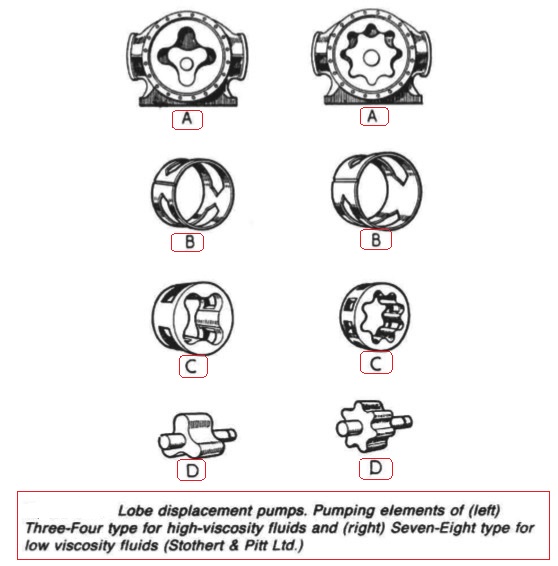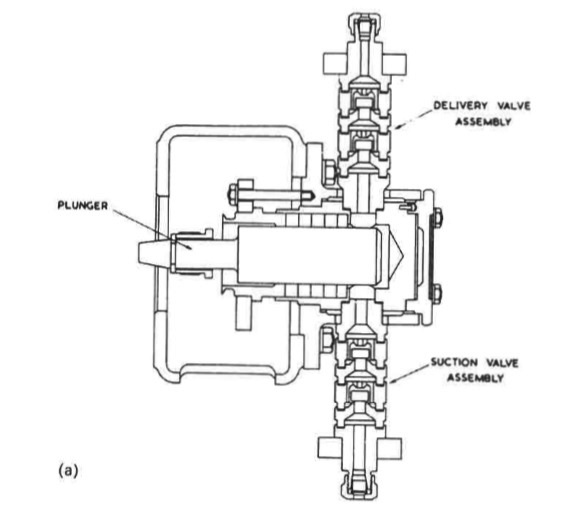
Home page||Marine Pumps ||
Lobe pumps & metering pumps -Marine pumps working procedure
Lobe pumps as manufactured by Stothert and Pitt have inner and outer
elements which rotate in a renewable liner fitted in the pump body. The inner
rotor is eccentric to the outer and is fitted to a shaft located by bearings in the
pump covers. The pump types are defined by the number of lobes and recesses,
for example Three—Four and Seven-Eight (Figure 1). As the rotors turn,
pockets of increasing and then decreasing capacity are created to give a
pumping action.
The normal maximum pressure is 21 bar with capacities of up to
400 tonne/hour. Special designs for up to 83 bar have been made for hydraulic
control applications.
The Three—Four types are particularly suited for handling high viscosity
fluids and are set to run at comparatively slow speeds which may require a gear
drive from the motor. The Seven—Eight types operate higher speeds, being
most efficient at around 720rev/min when handling fluids in the lower
viscosity range,

Figure 1:Lobe displacement pumps.
Pumping elements of (left)
Three-Four type for high-viscosity fluids and (right) Seven-Eight type for
low viscosity fluids (Stothert & Pitt Ltd.)
Metering pumps
A metering pump is designed primarily for measuring and dispensing a liquid,
rather than merely transferring it from one place to another. It has to be a
precisely designed piece of equipment, manufactured to close engineering
limits. It is frequently used to dispense concentrated and highly corrosive
liquids and for this reason considerable care has to be taken to ensure that the
materials used in construction, particularly those of parts in direct contact with
the liquid, will resist attack.
Most metering pumps are of the positive displacement type. They consist of
a prime mover, a drive mechanism and a pumphead. Pumpheads are usually of
the piston or plunger type (Figure 2a) where the purnp is to be used against
high pressures. For lower pressure duties the diaphragm version (Figure 2b)
is generally used. The plunger model is more exact in its performance than the
diaphragm type, but the diaphragm type which requires no glands, is
completely leak proof.
Pump output is controlled by varying the length of pump stroke. It is
possible to adjust output progressively from zero to maximum whilst the
pump is in operation as well as when it is at rest.
A further feature of many metering pumps is that arrangements are made in
design so that more than one pumphead and mechanism can be accommodated,
each with its own stroke control. Similarly each pumphead mechanism can be
equipped with a different gear ratio, thus enabling one pump to meter various
liquids in different ranges of flow rates. The metering pump is thus highly
versatile and capable of adaptation to a wide range of duties.

Figure 2 :Metering pump (a) Typical plunger head for MPL Type Q;
pump; .

Figure 2 (a) Typical plunger head for MPL Type Q
pump; (b) Typical diaphragm head for MPL Type Q pump
Summarized below some of the basic procedure of marine pumps and pumping system onboard :
- Axial flow pumps
An axial flow pump is one in which a screw propeller is used to create an increase in pressure by causing an axial acceleration of liquid within its blades. The incidental rotation imparted to the liquid is converted into straight axial movement by suitably shaped outlet guide vanes.....
- centrifugal pumps
Rotation of a centrifugal pump impeller causes the liquid it contains to move outwards from the centre to beyond the circumference of the impeller. The revolving liquid is impelled by centrifugal effect.....
- Centrifugal pump cavitation
Because of their self-priming ability, positive displacement pumps are widely used for lubricating oil duties. This practice is completely satisfactory in installations where the pump speed is variable but when the pump is driven by a constant speed a.c. motor it is necessary to arrange a bypass which can be closed in to boost flow. ....
- Gear pumps
Diesel engine and gearbox lubrication systems are normally supplied by gear
pumps which are independently driven for large slow speed engines and
stand-by duties but usually shaft driven for medium and high speed engines.
Gear pumps are also used for fuel and oil transfer, boiler combustion systems
and other duties.....
- General pumping system characteristics
A pump divides its pipe system into two distinct parts, each with different
characteristics. These are the suction and discharge sides. On the suction side
the drop in pressure that can be produced by a pump is limited to that of an
almost perfect vacuum. On the discharge side there is theoretically, no limit to
the height through which a liquid can be raised.....
- General purpose pumps
Single entry general purpose pumps are used for salt and fresh water circulating and also for bilge and ballast duties. The impeller is suspended from the shaft with no bottom support. ....
- Lobe pumps
Lobe pumps as manufactured by Stothert and Pitt have inner and outer
elements which rotate in a renewable liner fitted in the pump body. The inner
rotor is eccentric to the outer and is fitted to a shaft located by bearings in the
pump covers....
- Marine pumps construction
Marine pumps are usually installed with the shaft vertical and the motor above the pump. This positions the pump as low as possible for the best NPSH, takes up the least horizontal space and leaves the electric motor safer from gland or other leakage.....
- Pumps erosion
A pump handling liquids which contain abrasives, will suffer erosion on all internal surfaces, including bearings and shaft seals. The sea-water circulating pumps of ships operating in waters that contain large quantities of silt and sand
require frequent renewal of shaft seals or packing, also of shaft sleeves in way of the gland and bearings.....
- Rotary displacement pump
Positive displacement rotary pumps rely on fine clearances between moving
parts for their efficient operation. Excessive wear or erosion of parts, due to
friction contact or the presence of abrasives, is avoided by employing this type
of pump for specialized rather than general duties......
- Screw pumps
Both double-screw pumps, in which the screws are driven in phase by timing
gears , and triple screw pumps , in which the centre
screw is driven and the outer screws idle are used at sea especially for pumping
high viscosity liquids such as oil and some liquid cargoes.....
Home page||Cooling ||Machinery||Services ||Valves ||Pumps ||Auxiliary Power ||Propeller shaft ||Steering gears ||Ship stabilizers||Refrigeration||Air conditioning ||Deck machinery||Fire protection||Ship design
||Home ||
General Cargo Ship.com provide information on cargo ships various machinery systems -handling procedures, on board safety measures and some basic knowledge of cargo ships that might be useful for people working on board and those who working in the terminal. For any remarks please
Contact us
Copyright © 2010-2016 General Cargo Ship.com All rights reserved.
Terms and conditions of use
Read our privacy policy|| Home page||


